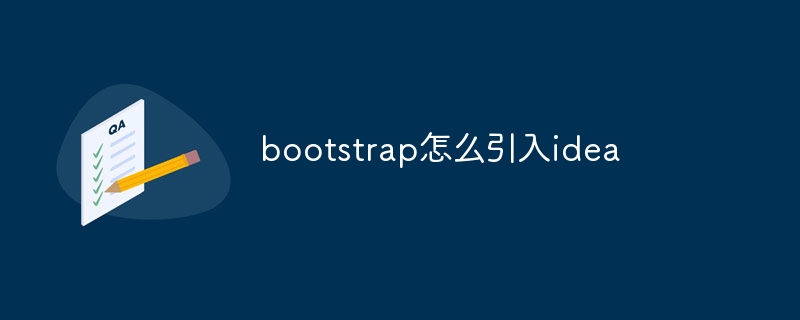How to introduce idea into bootstrap
Steps to introduce Bootstrap in IntelliJ IDEA: Create a new project and select "Web Application". Add "Bootstrap" Maven dependency. Create an HTML file and add Bootstrap references. Replace with the actual path to the Bootstrap CSS file. Run the HTML file to use Bootstrap styles. Tip: Use a CDN to import Bootstrap or customize HTML file templates.

How to introduce Bootstrap in IntelliJ IDEA
The steps to introduce Bootstrap in IntelliJ IDEA are as follows:
1. Create a new project
- Open IntelliJ IDEA and create a new Web project.
- Select "File" > "New" > "Project".
- In the "New Project" dialog box, select "Web Application" and click "Next".
2. Add Bootstrap dependencies
- Navigate to "File" > "Project Structure".
- In the "Project Structure" dialog box, select "Libraries".
- Click the "plus" icon and select "From Maven".
- In the "Maven Dependencies" dialog box, search for "Bootstrap".
- Find the latest version of "Bootstrap" and add it.
3. Configure HTML file
- Create a new HTML file in the project folder.
- Add the following code in the file:
<!DOCTYPE html> <html> <head> <meta charset="UTF-8"> <title>Bootstrap Page</title> <link rel="stylesheet" href="path/to/bootstrap.min.css"> </head> <body> <h1>Hello Bootstrap!</h1> </body> </html>
4. Replace the path
- with
path/to/ Replace bootstrap.min.csswith the actual path to the Bootstrap CSS file. - This file is usually located in the
targetfolder of the Maven repository.
5. Run the application
- Run the HTML file in IntelliJ IDEA.
- The page will be rendered using Bootstrap style.
Tip:
- Make sure Maven is configured correctly.
- You can also use CDN to introduce Bootstrap.
- You can customize the HTML file template through IntelliJ IDEA's "Preferences" > "Editor" > "File Templates" to automatically include Bootstrap references.
The above is the detailed content of How to introduce idea into bootstrap. For more information, please follow other related articles on the PHP Chinese website!

Hot AI Tools

Undresser.AI Undress
AI-powered app for creating realistic nude photos

AI Clothes Remover
Online AI tool for removing clothes from photos.

Undress AI Tool
Undress images for free

Clothoff.io
AI clothes remover

Video Face Swap
Swap faces in any video effortlessly with our completely free AI face swap tool!

Hot Article

Hot Tools

Notepad++7.3.1
Easy-to-use and free code editor

SublimeText3 Chinese version
Chinese version, very easy to use

Zend Studio 13.0.1
Powerful PHP integrated development environment

Dreamweaver CS6
Visual web development tools

SublimeText3 Mac version
God-level code editing software (SublimeText3)

Hot Topics
 How to use bootstrap in vue
Apr 07, 2025 pm 11:33 PM
How to use bootstrap in vue
Apr 07, 2025 pm 11:33 PM
Using Bootstrap in Vue.js is divided into five steps: Install Bootstrap. Import Bootstrap in main.js. Use the Bootstrap component directly in the template. Optional: Custom style. Optional: Use plug-ins.
 How to get the bootstrap search bar
Apr 07, 2025 pm 03:33 PM
How to get the bootstrap search bar
Apr 07, 2025 pm 03:33 PM
How to use Bootstrap to get the value of the search bar: Determines the ID or name of the search bar. Use JavaScript to get DOM elements. Gets the value of the element. Perform the required actions.
 The Roles of HTML, CSS, and JavaScript: Core Responsibilities
Apr 08, 2025 pm 07:05 PM
The Roles of HTML, CSS, and JavaScript: Core Responsibilities
Apr 08, 2025 pm 07:05 PM
HTML defines the web structure, CSS is responsible for style and layout, and JavaScript gives dynamic interaction. The three perform their duties in web development and jointly build a colorful website.
 Understanding HTML, CSS, and JavaScript: A Beginner's Guide
Apr 12, 2025 am 12:02 AM
Understanding HTML, CSS, and JavaScript: A Beginner's Guide
Apr 12, 2025 am 12:02 AM
WebdevelopmentreliesonHTML,CSS,andJavaScript:1)HTMLstructurescontent,2)CSSstylesit,and3)JavaScriptaddsinteractivity,formingthebasisofmodernwebexperiences.
 How to set up the framework for bootstrap
Apr 07, 2025 pm 03:27 PM
How to set up the framework for bootstrap
Apr 07, 2025 pm 03:27 PM
To set up the Bootstrap framework, you need to follow these steps: 1. Reference the Bootstrap file via CDN; 2. Download and host the file on your own server; 3. Include the Bootstrap file in HTML; 4. Compile Sass/Less as needed; 5. Import a custom file (optional). Once setup is complete, you can use Bootstrap's grid systems, components, and styles to create responsive websites and applications.
 How to insert pictures on bootstrap
Apr 07, 2025 pm 03:30 PM
How to insert pictures on bootstrap
Apr 07, 2025 pm 03:30 PM
There are several ways to insert images in Bootstrap: insert images directly, using the HTML img tag. With the Bootstrap image component, you can provide responsive images and more styles. Set the image size, use the img-fluid class to make the image adaptable. Set the border, using the img-bordered class. Set the rounded corners and use the img-rounded class. Set the shadow, use the shadow class. Resize and position the image, using CSS style. Using the background image, use the background-image CSS property.
 HTML: The Structure, CSS: The Style, JavaScript: The Behavior
Apr 18, 2025 am 12:09 AM
HTML: The Structure, CSS: The Style, JavaScript: The Behavior
Apr 18, 2025 am 12:09 AM
The roles of HTML, CSS and JavaScript in web development are: 1. HTML defines the web page structure, 2. CSS controls the web page style, and 3. JavaScript adds dynamic behavior. Together, they build the framework, aesthetics and interactivity of modern websites.
 How to do bootstrap modal box
Apr 07, 2025 pm 03:24 PM
How to do bootstrap modal box
Apr 07, 2025 pm 03:24 PM
How to create modal boxes using Bootstrap? Create a modal box with the appropriate HTML structure. Includes Bootstrap and jQuery libraries to enable modal functionality. Use JavaScript or jQuery code to display or hide modal boxes.






